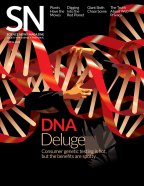Readers question killer macros and spinning wheels
Your comments and questions on the August 31, 2019 issue of Science News
- More than 2 years ago

Under a macroscope
A theoretical dark matter particle called a macro would have to be about 1 square micrometer in size traveling at hypersonic speed to kill a person, Lisa Grossman reported in “Dark matter particles won’t kill you. If they could, they would have already” (SN: 8/31/19, p. 4).
A macro that size would deposit as much energy as a metal bullet and vaporize tissue, researchers theorize.If a macro “were to deposit energy in tissue, it would do likewise in any other kind of matter, such as the atmosphere, no?” reader Clay Naff asked. “We’d expect a superheated atmosphere rather than riddled bodies, wouldn’t we?”
If macros exist, then they could interact with the atmosphere as they fall to Earth, says physicist Glenn Starkman of Case Western Reserve University in Cleveland. The amount of energy that macros release into the atmosphere would depend on the particles’ size, which is still an unknown. Micrometer-sized macros would hold on to most of their energy, contributing little heat to the atmosphere, whereas larger macros would release most of their energy. Either way, macro strikes would be too few and far between to superheat the atmosphere — or kill millions of people, Starkman says. Cosmic ray detectors may be able to pick up macros falling to Earth, Starkman suggests. “The point is that the rare events are detectable — one person killed (or not), a cosmic ray detector alerted (or not).”
Spin zone
Researchers are using ancient spinning and weaving tools to unravel how people made textiles long ago, Amber Dance reported in “Textile archaeologists use ancient tools to weave a tapestry of the past” (SN: 8/31/19, p. 16).
Reader Duren Thompson was disappointed that the article didn’t mention other spinning wheels used before the wheel called the spinning jenny, invented in 1764 in England. Thompson noted that the story ignores “the early medieval Asian and Middle Eastern (and later medieval European) engineering innovations that laid the foundation for the spinning jenny.”Thompson is correct that the spinning jenny came after other thread-spinning wheels, says Eva Andersson Strand, director of the Centre for Textile Research at the University of Copenhagen. The first spinning wheel likely originated in Asia around the 11th century. Over the next few centuries, the technology spread to other parts of the world. Some notable wheels that came before the spinning jenny are the great wheel and the treadle wheel. But the spinning jenny was a key innovation in industrial weaving.
The award goes to …

Tina Hesman Saey, Science News’ molecular biology writer, has won a National Academies of Sciences, Engineering and Medicine 2019 Communications Award for her series “Genetic testing goes mainstream” (SN: 5/26/18, p. 20). Judges called it a “timely, informative and eminently readable series on the uses and limitations of DNA testing for both medical and ancestry purposes.” The prize recognizes excellence in reporting and communicating science, engineering and medicine to the public. Saey will be honored October 16 at a ceremony in Washington, D.C.